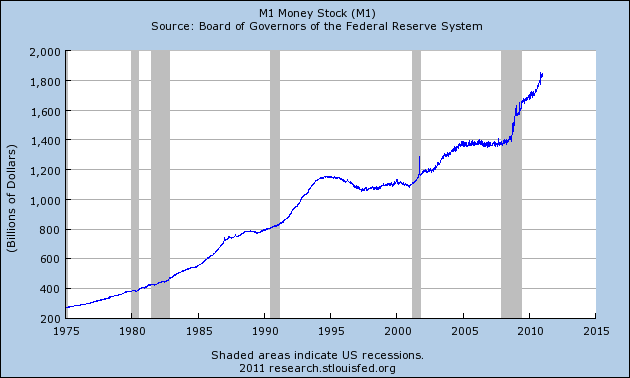 If the U.S. economy “grows” by 4 percent in 2011, but by the end of the year we are paying $3.00 for a loaf of bread, $4.00 for a gallon of milk and $5.00 for a gallon of gasoline are the American people going to be better off economically or worse off? The answer is obvious, but most “experts” in the mainstream media continue to insist that as long as U.S. GDP is increasing and as long as the stock market is going up that our economy is improving. But that is just not the case. If the amount of money in circulation was relatively constant, those measurements would be helpful, but unfortunately the U.S. government and the Federal Reserve are dramatically pumping up the money supply right now. Just because larger amounts of paper money are changing hands does not mean that the economy is getting stronger. Of course GDP is going to rise when there is much more money in the system. But economic growth that is fueled by inflation is just an illusion and it is not an indicator of economic health at all.
If the U.S. economy “grows” by 4 percent in 2011, but by the end of the year we are paying $3.00 for a loaf of bread, $4.00 for a gallon of milk and $5.00 for a gallon of gasoline are the American people going to be better off economically or worse off? The answer is obvious, but most “experts” in the mainstream media continue to insist that as long as U.S. GDP is increasing and as long as the stock market is going up that our economy is improving. But that is just not the case. If the amount of money in circulation was relatively constant, those measurements would be helpful, but unfortunately the U.S. government and the Federal Reserve are dramatically pumping up the money supply right now. Just because larger amounts of paper money are changing hands does not mean that the economy is getting stronger. Of course GDP is going to rise when there is much more money in the system. But economic growth that is fueled by inflation is just an illusion and it is not an indicator of economic health at all.
A very basic example shows this very easily. Imagine if suddenly everyone in the United States had the amount of money they owned instantly doubled. Would the U.S. economy be twice as healthy? Of course not. Very quickly prices would rise to meet the new level of money.
Well, in the United States today our “authorities” are pumping massive amounts of new dollars into the system. That is one reason why so many people are so upset about the Federal Reserve’s “quantitative easing 2” program. The Federal Reserve is creating money out of thin air and pumping it into the financial system. The first people that get their hands on this new money are Wall Street banks and major financial institutions. The idea is that eventually all of this new money will “trickle down” and will help average Americans, but that just does not seem to be happening.
In addition, when the U.S. government goes into more debt, this also creates more money. The U.S. government has accumulated far more new debt during the last two years than it ever has in any other two year period. When the U.S. government spends all of this money that it borrows it introduces a massive amount of new money into the system.
There are many ways to measure the money supply, and one of the most basic (M1) is displayed below. As you can see, thanks to the actions of the Federal Reserve and the U.S. government, the money supply is rising at an almost exponential rate at this point. The money supply has grown rapidly at various points in the past, but what we are witnessing now is really unprecedented…..
So what happens when you have a lot more money chasing roughly the same number of goods and services?
Well, you have inflation of course.
Are our “leaders” alarmed by any of this?
No, in fact they plan to pump up the money supply even more. The Federal Reserve seems content to continue their “quantitative easing” program and Barack Obama is proposing all kinds of new federal spending which will be funded by more debt.
So the truth is that we had better have some significant “economic growth” during 2011. If this amount of money is pumped into our financial system and we don’t see any “economic growth” then that would be an indication of a major league economic breakdown.
But instead of looking at things rationally, many mainstream economists are hailing the fact that the U.S. economy may grow by a few percentage points in 2011 as a sign that happy days are here again.
According to a recent article in USA Today, economists are becoming increasingly optimistic about 2011, and the consensus seems to be that economic growth in the United States will fall somewhere between 3 and 4 percent….
Economists are more optimistic about the recovery than they were just a few months ago, significantly upgrading their forecasts for 2011 as consumers open their wallets.
Unfortunately, the irrational optimism is not limited to just the United States. As global leaders prepare to descend on the annual meeting of the World Economic Forum in Davos, Switzerland many mainstream media outlets are declaring that the worldwide financial crisis is over and that we are now entering a glorious boom time for the global economy. For example, the following is how one recent article from Bloomberg opened….
For only the third time since the Industrial Revolution, the world may be entering a long-term growth cycle that will lift all economies simultaneously, driving bond yields and commodity prices higher.
People don’t seem to realize that just because more money is changing hands and just because financial markets are going higher that it doesn’t mean that the economic situation is improving.
If a rising GDP and a soaring stock market truly were strong indicators of economic health, then Zimbabwe would have been one of the strongest economies on the planet over the last 10 years.
Inflation changes everything.
Unfortunately, official U.S. government inflation figures have become so manipulated that they are of basically no value at this point. Whenever one particular category starts to experience significant inflation, the U.S. government simply removes that category from the inflation calculations. Over the past 40 years the way that inflation is calculated has been changed way too many times.
If you really want to get a good idea of what is happening with inflation, a good thing to do is to look at the basic commodities that everyone uses around the world.
For example, according to the United Nations, the global price of food hit an all-time high in December. Not only that, but almost every major agricultural commodity that you could possibly name experienced a double-digit percentage increase in price during 2010.
In addition, the price of oil is steamrolling towards $100 a barrel again. In fact, many analysts are convinced that the price of oil will set a new all-time record in 2011.
A recent editorial in Newsweek was not optimistic that we will be able to stem this rising tide of inflation….
The final dam to stopping $150-a-barrel oil and $4-a-gallon gas is being breached, as financial regulation continues its daily erosion into worthlessness.
So what is the answer to these problems?
Well, according to many of the top “economic leaders” in the world, the solution is to create even more money and even more credit.
Between 2000 and 2009, the total amount of credit in the world grew from 57 trillion dollars to 109 trillion dollars. Now the World Economic Forum says that we need to grow the total amount of credit by another 100 trillion dollars over the next ten years to “support” the anticipated amount of “economic growth” around the world that they expect to see.
Does that make any sense?
We have to double the amount of debt in the world so that the world economy can grow?
But this is what the world economic system has become at this point. It is a never ending debt spiral that requires constantly increasing levels of debt and paper money.
That is a huge reason why precious metals such as gold and silver are becoming so popular. Investors are becoming sick and tired of the constantly inflating paper currencies. Gold and silver are both very much in demand right now. For example, the Chinese are voraciously gobbling up gold right now. Also, the Central Bank of Russia has announced plans to purchase 100 metric tons of gold per year in order “to replenish the country’s gold reserves”.
But what about average Americans? What is going to happen to them in a world where prices are rising rapidly?
Well, the answer is very simple. In an environment of rapidly rising prices, the standard of living for most Americans is going to go down.
In this economic environment, employers are simply not going to increase salaries fast enough to keep up with the rising price of food, gas and health care.
In addition, there are tens of millions of Americans that are on fixed incomes. As prices rise, those fixed incomes will simply not go as far.
So the truth is that most Americans are going to find their finances stretched even thinner in the months and years to come.
Inflation is like a thief. When prices rise it means that the purchasing power of all the dollars that we have accumulated goes down.
But for our politicians, inflation can be a helpful thing. They can take inflation-fueled “economic growth” numbers and claim that their policies are working and that the economy is becoming healthier.
A year from now when these jokers trot out their “economic growth” numbers and yet the cost of nearly everything you buy has increased dramatically, don’t you believe their propaganda.
Yes, U.S. economic numbers are most likely going to experience a little bit of inflation-fueled “growth” in 2011.
But it will not mean that our economy is improving.
